window CITROEN DS3 2018 Handbook (in English)
[x] Cancel search | Manufacturer: CITROEN, Model Year: 2018, Model line: DS3, Model: CITROEN DS3 2018Pages: 248, PDF Size: 8.79 MB
Page 4 of 248

2
01
02
03
04
05
9 Instrument panels
12
W
arning and indicator lamps
24
Indicators
30
L
ighting dimmer control
31
B
lack panel
31
M
onochrome screen A
33
M
onochrome screen C
34
T
ouch screen tablet
38
T
rip computer
40
D
ate and time adjustment
4
I
nstruments and controls
43
K
ey with remote control
46
Alarm
47
E
lectric windows
49
D
oors
49
C
entral locking
51 C onvertible roof
57 Boot
61
F
ront seats
66
R
ear seats
67
S
teering wheel adjustment
67
Mirrors
68
V
entilation
70
R
ecommendations for ventilation and air
conditioning
71
H
eating
71
M
anual air conditioning
72
A
utomatic air conditioning
74
R
ecirculation of interior air
74
F
ront demist – defrost
75
R
ear screen demist – defrost
76
F
ragrance diffuser
77
C
ourtesy lamp
77
I
nterior mood lighting
78 Interior
fi
ttings
81 Boot
fittings84
L
ighting control stalk
86
D
irection indicators
86
A
utomatic illumination of headlamps
87
LE
D daytime running lamps
87
H
eadlamp beam height adjustment
88 W iper control stalk
92
G
eneral safety recommendations
93
H
azard warning lamps
93
H
orn
93
E
mergency or assistance call
96
E
lectronic stability control (ESC)
98
Se
at belts
101
Airbags
104
Ch
ild seats
105
D
eactivating the passenger's front airbag
111
I
SOFIX mountings and child seats
Over view
Instruments Access
Ease of use and comfort Safety Lighting and visibility
Eco-driving
Contents
Page 6 of 248
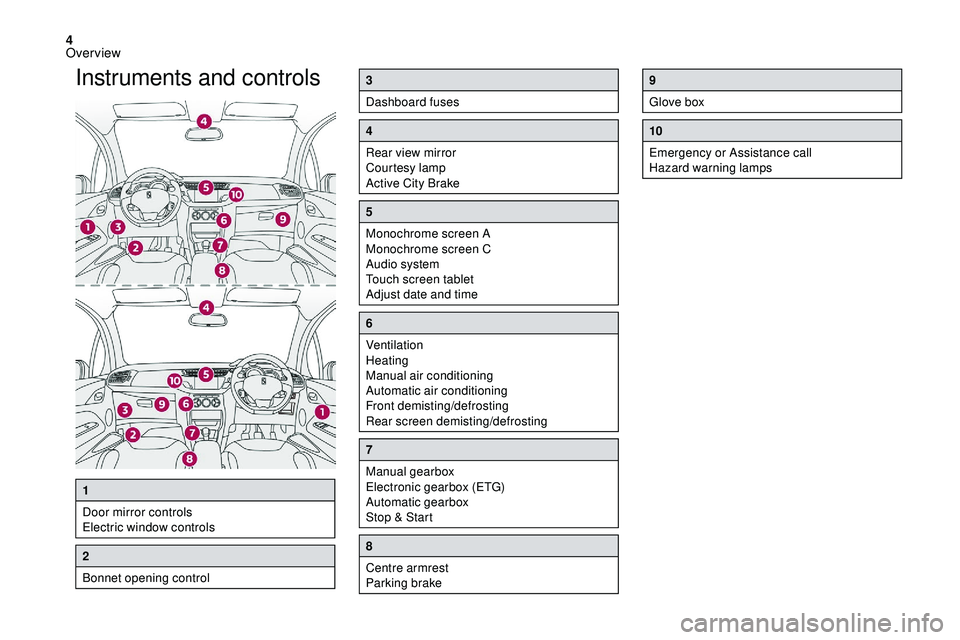
4
Instruments and controls3
Dashboard fuses
4
Rear view mirror
Courtesy lamp
Active City Brake
5
Monochrome screen A
Monochrome screen C
Audio system
Touch screen tablet
Adjust date and time
6
Ventilation
Heating
Manual air conditioning
Automatic air conditioning
Front demisting/defrosting
Rear screen demisting/defrosting
7
Manual gearbox
Electronic gearbox (ETG)
Automatic gearbox
Stop & Start
8
Centre armrest
Parking brake
9
Glove box
10
Emergency or Assistance call
Hazard warning lamps
1
Door mirror controls
Electric window controls
2
Bonnet opening control
Over view
Page 8 of 248

6
Eco-driving
Eco-driving is a range of everyday practices
t hat allow the motorist to optimise their fuel
consumption and CO
2 emissions.
Optimise the use of your gearbox
With a manual gearbox, move off gently
an d change up without waiting. During
acceleration, change up early.
With an automatic gearbox, give preference
to automatic mode and avoid pressing the
accelerator pedal heavily or suddenly.
The gear efficiency indicator invites you to
engage the most suitable gear: as soon as the
indication is displayed in the instrument panel,
follow it straight away.
For vehicles fitted with an automatic gearbox,
this indicator appears only in manual mode.
Drive smoothly
Maintain a safe distance between vehicles,
u se engine braking rather than the
brake pedal, and press the accelerator
progressively. These practices contribute
towards a
reduction in fuel consumption and
CO
2 emissions and also help reduce the
b
ackground traffic noise.
If your vehicle has cruise control, make use of
the system at speeds above 25
mph (40 km/h)
when the traffic is flowing well.
Control the use of your electrical
equipment
Switch off the demisting and defrosting
controls, if these are not automatically
managed.
Switch off the heated seat as soon as
possible.
Switch off the headlamps and front foglamps
when the ambient light level does not require
their use.
Avoid running the engine before moving off,
particularly in winter; your vehicle will warm up
much faster while driving.
Before moving off, if the passenger
compartment is too warm, ventilate it by
opening the windows and air vents before
using the air conditioning.
Above 30
mph (50
km/h), close the windows
and leave the air vents open.
Consider using equipment that can help
keep the temperature in the passenger
compartment down (sunroof blind and window
blinds, etc.).
Unless it has automatic regulation, switch off
the air conditioning as soon as the desired
temperature has been reached. As a
passenger, if you avoid connecting your
multimedia devices (film, music, video game,
etc.), you will contribute towards limiting the
consumption of electrical energy, and so of
fuel.
Disconnect your portable devices before
leaving the vehicle.
Eco-driving
Page 48 of 248
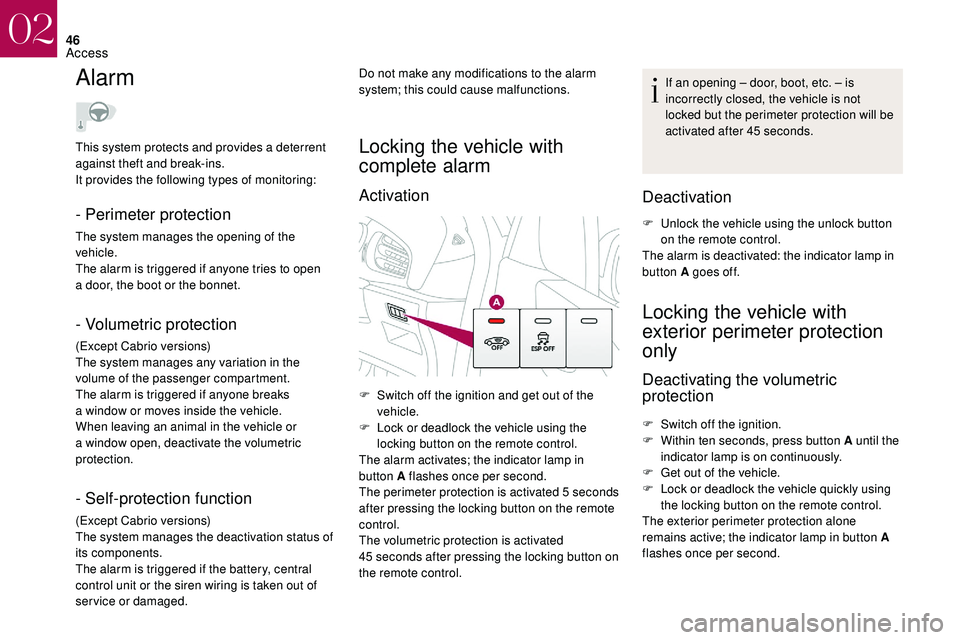
46
Alarm
- Perimeter protection
The system manages the opening of the
vehicle.
The alarm is triggered if anyone tries to open
a door, the boot or the bonnet.
- Volumetric protection
(Except Cabrio versions)
The system manages any variation in the
volume of the passenger compartment.
The alarm is triggered if anyone breaks
a
window or moves inside the vehicle.
When leaving an animal in the vehicle or
a
window open, deactivate the volumetric
protection. This system protects and provides a deterrent
against theft and break-ins.
It provides the following types of monitoring: Do not make any modifications to the alarm
system; this could cause malfunctions.
Locking the vehicle with
complete alarm
Activation
F Switch off the ignition and get out of the
vehicle.
F
L
ock or deadlock the vehicle using the
locking button on the remote control.
The alarm activates; the indicator lamp in
button A flashes once per second.
The perimeter protection is activated 5
seconds
after pressing the locking button on the remote
control.
The volumetric protection is activated
45
seconds after pressing the locking button on
the remote control. If an opening – door, boot, etc. – is
incorrectly closed, the vehicle is not
locked but the perimeter protection will be
activated after 45
seconds.
Deactivation
F Unlock the vehicle using the unlock button
on the remote control.
The alarm is deactivated: the indicator lamp in
button A goes off.
Locking the vehicle with
exterior perimeter protection
only
Deactivating the volumetric
protection
F Switch off the ignition.
F W ithin ten seconds, press button A until the
indicator lamp is on continuously.
F
G
et out of the vehicle.
F
L
ock or deadlock the vehicle quickly using
the locking button on the remote control.
The exterior perimeter protection alone
remains active; the indicator lamp in button A
flashes once per second.
- Self-protection function
(Except Cabrio versions)
The system manages the deactivation status of
its components.
The alarm is triggered if the battery, central
control unit or the siren wiring is taken out of
service or damaged.
02
Access
Page 49 of 248
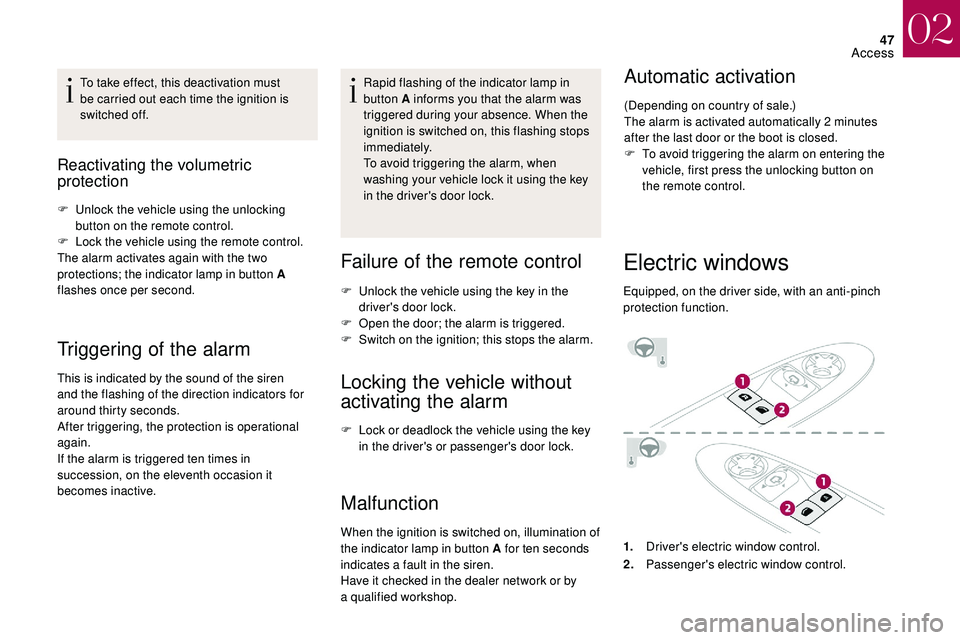
47
To take effect, this deactivation must
be carried out each time the ignition is
switched off.
Reactivating the volumetric
protection
F Unlock the vehicle using the unlocking button on the remote control.
F
L
ock the vehicle using the remote control.
The alarm activates again with the two
protections; the indicator lamp in button A
flashes once per second.
Triggering of the alarm
This is indicated by the sound of the siren
and the flashing of the direction indicators for
around thirty seconds.
After triggering, the protection is operational
again.
If the alarm is triggered ten times in
succession, on the eleventh occasion it
becomes inactive. Rapid flashing of the indicator lamp in
button A informs you that the alarm was
triggered during your absence. When the
ignition is switched on, this flashing stops
immediately.
To avoid triggering the alarm, when
washing your vehicle lock it using the key
in the driver's door lock.
Failure of the remote control
F Unlock the vehicle using the key in the
driver's door lock.
F
O
pen the door; the alarm is triggered.
F
S
witch on the ignition; this stops the alarm.
Locking the vehicle without
activating the alarm
F Lock or deadlock the vehicle using the key in the driver's or passenger's door lock.
Malfunction
When the ignition is switched on, illumination of
the indicator lamp in button A for ten seconds
indicates a
fault in the siren.
Have it checked in the dealer network or by
a
qualified workshop.
Automatic activation
(Depending on country of sale.)
The alarm is activated automatically 2 minutes
after the last door or the boot is closed.
F
T
o avoid triggering the alarm on entering the
vehicle, first press the unlocking button on
the remote control.
Electric windows
Equipped, on the driver side, with an anti-pinch
protection function.
1. Driver's electric window control.
2. Passenger's electric window control.
02
Access
Page 50 of 248
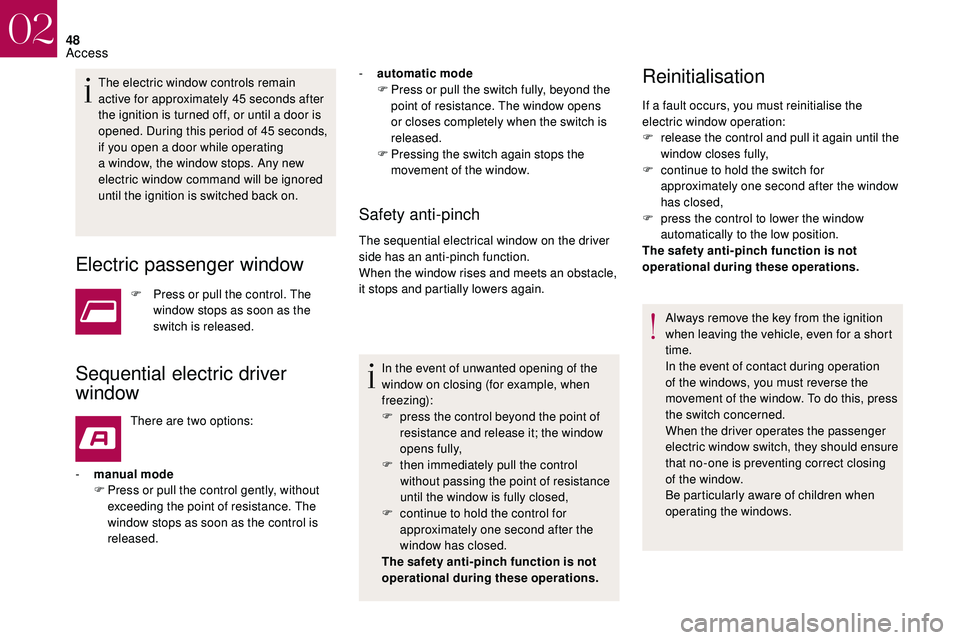
48
The electric window controls remain
active for approximately 45 seconds after
the ignition is turned off, or until a
door is
opened. During this period of 45
seconds,
if you open a
door while operating
a
window, the window stops. Any new
electric window command will be ignored
until the ignition is switched back on.
Electric passenger window
F Press or pull the control. The window stops as soon as the
switch is released.
Sequential electric driver
window
There are two options:
-
man
ual mode
F
P
ress or pull the control gently, without
exceeding the point of resistance. The
window stops as soon as the control is
released.
Safety anti-pinch
The sequential electrical window on the driver
side has an anti-pinch function.
When the window rises and meets an obstacle,
it stops and partially lowers again.
In the event of unwanted opening of the
window on closing (for example, when
f re ezing):
F
p
ress the control beyond the point of
resistance and release it; the window
opens fully,
F
t
hen immediately pull the control
without passing the point of resistance
until the window is fully closed,
F
c
ontinue to hold the control for
approximately one second after the
window has closed.
The safety anti-pinch function is not
operational during these operations.
Reinitialisation
If a fault occurs, you must reinitialise the
el ectric window operation:
F
r
elease the control and pull it again until the
window closes fully,
F
c
ontinue to hold the switch for
approximately one second after the window
has closed,
F
p
ress the control to lower the window
automatically to the low position.
The safety anti-pinch function is not
operational during these operations.
-
a
utomatic mode
F
P
ress or pull the switch fully, beyond the
point of resistance. The window opens
or closes completely when the switch is
released.
F
P
ressing the switch again stops the
movement of the window.
Always remove the key from the ignition
when leaving the vehicle, even for a
short
time.
In the event of contact during operation
of the windows, you must reverse the
movement of the window. To do this, press
the switch concerned.
When the driver operates the passenger
electric window switch, they should ensure
that no-one is preventing correct closing
of the window.
Be particularly aware of children when
operating the windows.
02
Access
Page 58 of 248
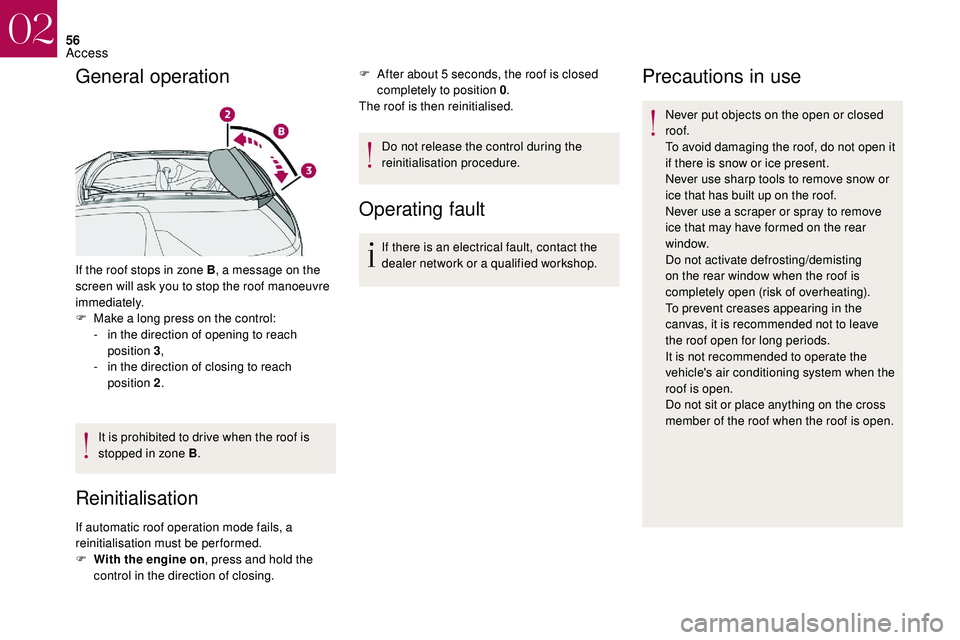
56
General operation
If the roof stops in zone B, a message on the
screen will ask you to stop the roof manoeuvre
immediately.
F
M
ake a long press on the control:
-
i
n the direction of opening to reach
position 3 ,
-
i
n the direction of closing to reach
position 2 .
It is prohibited to drive when the roof is
stopped in zone B .
Reinitialisation
If automatic roof operation mode fails, a
reinitialisation must be performed.
F
W
ith the engine on, press and hold the
control in the direction of closing. F
A
fter about 5 seconds, the roof is closed
completely to position 0 .
The roof is then reinitialised.
Do not release the control during the
reinitialisation procedure.
Operating fault
If there is an electrical fault, contact the
dealer network or a qualified workshop.
Precautions in use
Never put objects on the open or closed
roof.
To avoid damaging the roof, do not open it
if there is snow or ice present.
Never use sharp tools to remove snow or
ice that has built up on the roof.
Never use a
scraper or spray to remove
ice that may have formed on the rear
window.
Do not activate defrosting/demisting
on the rear window when the roof is
completely open (risk of overheating).
To prevent creases appearing in the
canvas, it is recommended not to leave
the roof open for long periods.
It is not recommended to operate the
vehicle's air conditioning system when the
roof is open.
Do not sit or place anything on the cross
member of the roof when the roof is open.
02
Access
Page 71 of 248
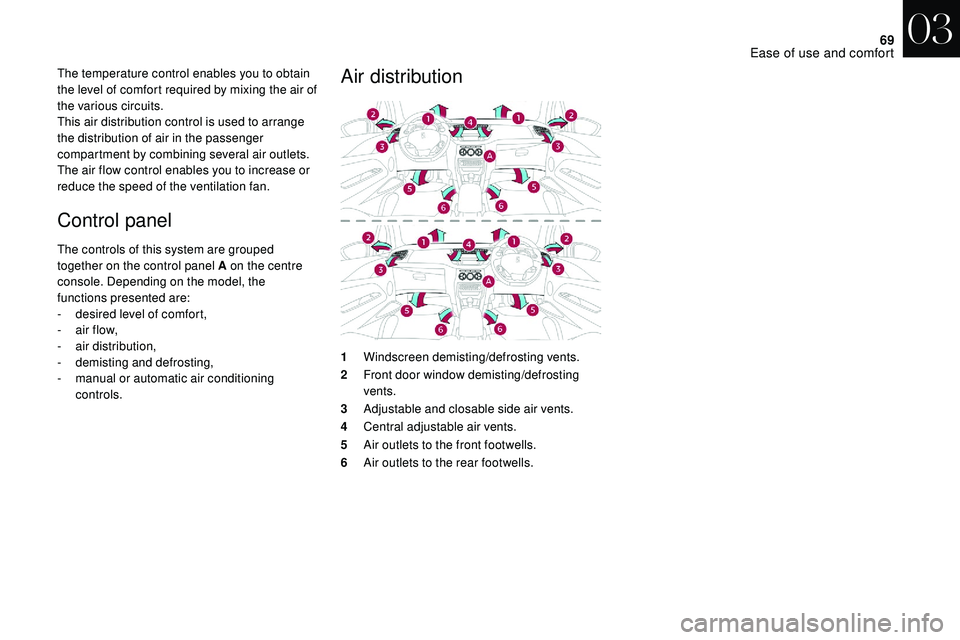
69
The temperature control enables you to obtain
the level of comfort required by mixing the air of
the various circuits.
This air distribution control is used to arrange
the distribution of air in the passenger
compartment by combining several air outlets.
The air flow control enables you to increase or
reduce the speed of the ventilation fan.
Control panel
The controls of this system are grouped
together on the control panel A on the centre
console. Depending on the model, the
functions presented are:
-
d
esired level of comfort,
-
a
ir flow,
-
a
ir distribution,
-
d
emisting and defrosting,
-
m
anual or automatic air conditioning
controls.
Air distribution
1 Windscreen demisting/defrosting vents.
2 Front door window demisting/defrosting
vents.
3 Adjustable and closable side air vents.
4 Central adjustable air vents.
5 Air outlets to the front footwells.
6 Air outlets to the rear footwells.
03
Ease of use and comfort
Page 72 of 248
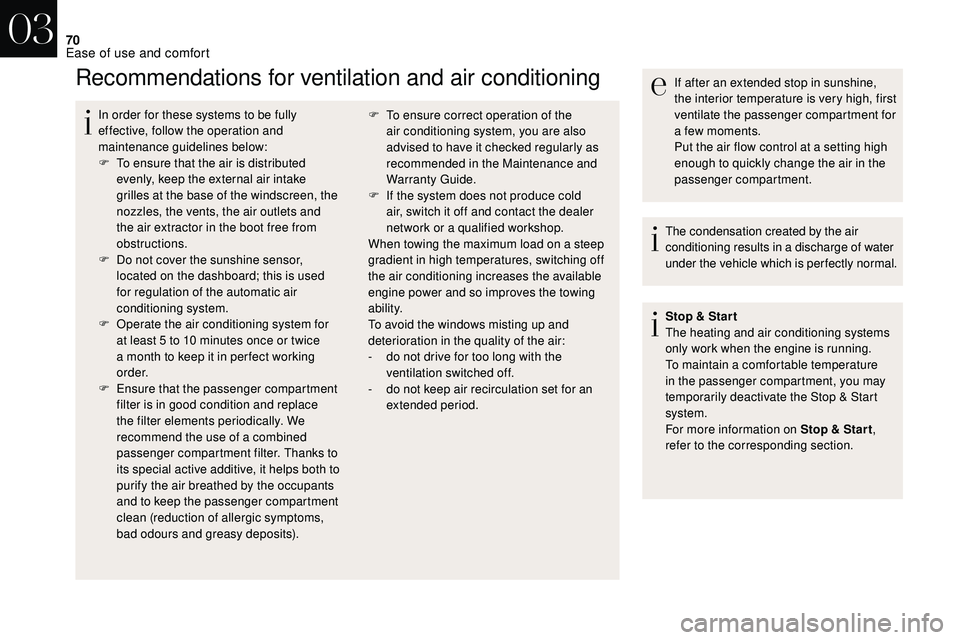
70
Recommendations for ventilation and air conditioning
In order for these systems to be fully
effective, follow the operation and
maintenance guidelines below:
F
T
o ensure that the air is distributed
evenly, keep the external air intake
grilles at the base of the windscreen, the
nozzles, the vents, the air outlets and
the air extractor in the boot free from
obstructions.
F
D
o not cover the sunshine sensor,
located on the dashboard; this is used
for regulation of the automatic air
conditioning system.
F
O
perate the air conditioning system for
at least 5
to 10 minutes once or twice
a
month to keep it in per fect working
o r d e r.
F
E
nsure that the passenger compartment
filter is in good condition and replace
the filter elements periodically. We
recommend the use of a
combined
passenger compartment filter. Thanks to
its special active additive, it helps both to
purify the air breathed by the occupants
and to keep the passenger compartment
clean (reduction of allergic symptoms,
bad odours and greasy deposits). If after an extended stop in sunshine,
the interior temperature is very high, first
ventilate the passenger compartment for
a
few moments.
Put the air flow control at a
setting high
enough to quickly change the air in the
passenger compartment.
The condensation created by the air
conditioning results in a
discharge of water
under the vehicle which is per fectly normal.
Stop & Star t
The heating and air conditioning systems
only work when the engine is running.
To maintain a
comfortable temperature
in the passenger compartment, you may
temporarily deactivate the Stop & Start
system.
For more information on Stop & Star t ,
refer to the corresponding section.
F
T o ensure correct operation of the
air conditioning system, you are also
advised to have it checked regularly as
recommended in the Maintenance and
Warranty Guide.
F
I
f the system does not produce cold
air, switch it off and contact the dealer
network or a
qualified workshop.
When towing the maximum load on a
steep
gradient in high temperatures, switching off
the air conditioning increases the available
engine power and so improves the towing
ability.
To avoid the windows misting up and
deterioration in the quality of the air:
-
d
o not drive for too long with the
ventilation switched off.
-
d
o not keep air recirculation set for an
extended period.
03
Ease of use and comfort
Page 73 of 248
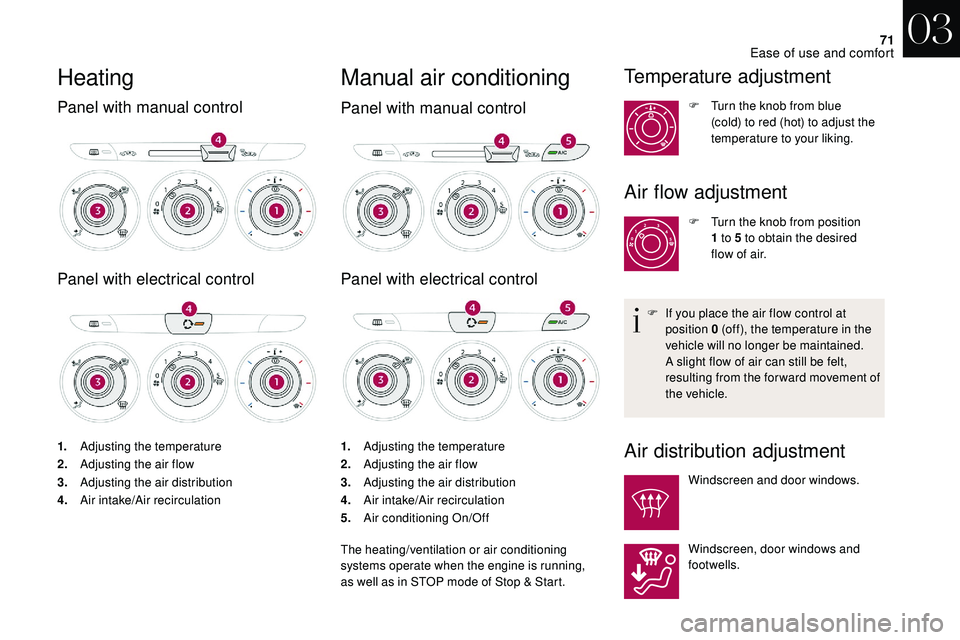
71
Heating
Panel with manual control
Panel with electrical control
1.Adjusting the temperature
2. Adjusting the air flow
3. Adjusting the air distribution
4. Air intake/Air recirculation 1.
Adjusting the temperature
2. Adjusting the air flow
3. Adjusting the air distribution
4. Air intake/Air recirculation
5. Air conditioning On/Off
The heating/ventilation or air conditioning
systems operate when the engine is running,
as well as in STOP mode of Stop & Start.
Manual air conditioning
Panel with manual control
Panel with electrical control
Temperature adjustment
F Turn the knob from blue (cold) to red (hot) to adjust the
temperature to your liking.
Air flow adjustment
F Turn the knob from position 1 to 5 to obtain the desired
flow of air.
F
I
f you place the air flow control at
position 0
(off), the temperature in the
vehicle will no longer be maintained.
A slight flow of air can still be felt,
resulting from the for ward movement of
the vehicle.
Air distribution adjustment
Windscreen and door windows.
Windscreen, door windows and
footwells.
03
Ease of use and comfort